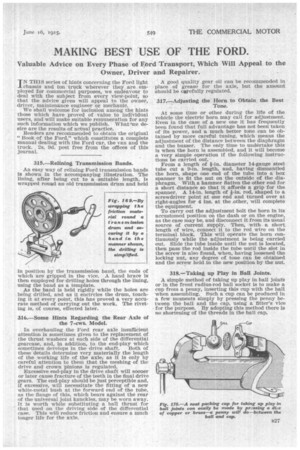MAKING BEST USE OF THE FORD.
Page 11

If you've noticed an error in this article please click here to report it so we can fix it.
Valuable Advice on Every Phase of Ford Transport, Which Will Appeal to the Owner, Driver and Repairer.
IN THIS series of hints concerning the Ford light chassis and ton truck wherever they are employed for commercial purposes, we endeavour to deal with the subject from every view-point, so that the advice given will appeal to the owner, driver, maintenance engineer or mechanic. We shall welcome for inclusion among the hints those which have proved of value to individual users, and will make suitable remuneration for any such information which we publish. What 'we desire are the results of actual practice. Readers are recommended to obtain the original "Book of the Ford," which constitutes a complete manual dealing with the Ford car, the van and the truck. 2s. 901, post free from the offices of this journal.
315.—Relining Transmission Bands.
An easy way of relining Ford transmission bands Is shown in the accompanying illustration. The lining, after being cut to a suitable length, is wrapped round an old transmission dritm and held in position by the transmission band, the ends of which are gripped in the vice. A hand brace is then employed for drilling holes through the lining, using the band as a template.
As the band is held rigidly while the holes are being drilled, and as it encircles the drum, touching it at every point, this has proved a very accurate method of carrying out the work. The riveting is, of course, effected later.
316.—Some Hints Regarding the Rear Axle of the 7-cwt. Model.
In overhauling the Ford rear axle insufficient attention is sometimes given to the replacement of the thrust washers at each side of the differential gearcase, and, in addition, to the end-play which sometimes develops in the drive shaft. Both of these details determine very materially the length of the working life of the axle, as it is only by careful attention to them that the meshing of the drive and crown pinions is regulated.
Excessive end-play in the drive shaft will sooner or later cause fracture o,f the teeth in the final drive gears. The end-play should be just perceptible and, if excessive, will necessitate the fitting of a new white-metal bush at the forward end of the tube, as the flange of this, which bears against the rear of the universal joint knuckles, may be worn away. It is worth while substituting a ball thrust for that used on the driving side of the differential case. This will reduce friction and ensure a much longer life for the axle. A good quality gear oil can be recommended in place of grease for the axle, but the amount should be carefully regulated.
• 317.—Adjusting the Horn to Obtain the Best Tone.
At some time or other during the life of the vehicle the electric horn may call for adjustment. Even in the case of a new one it has frequently been found that full advantage has not been taken of its power, and a much better tone can be obtained by more careful tuning, which means the adjustment of the distance between the diaphragm and the buzzer. The only time to undertake this is when the horn is assembled, and it will become a very simple operation if the following instructions be carried out.
From a length of ft-in. diameter 14-gauge steel tube cut a 9-in, length, and, having dismantled the horn, shape one end of the tube into a box spanner to fit the nut on the outside of the diaphragm. With a hammer flatten the other end for a short distance so that it affords a grip for the spanner. A 14-in, length of fin, rod, shaped to a screwdriver point at one end and turned over at right-angles for 4 ins, at the other, will complete the equipment.
To carry out the adjustment bolt the horn in its accustomed position on the dash or on the engine, as the case may be, and disconnect it from its usual source of current supply. Then, with a short length of wire, connect it to the red wire on the terminal block. This will operate the horn continuously while the adjustment is being carried out. Slide the tube inside until the nut is located, then pass the rod inside the tube until the slot in the screw is also found, when, having loosened the locking nut, any degree of tone can be obtained and the screw held in the new position by the nut.
318.—Taking up Play in Ball Joints.
A simple method of taking up play in ball joints or In the front radius-rod ball socket is to make a cup from a penny, inserting this cup with the ball when assembling. Such a cup can be produced in a few moments simply by pressing the penny between the ball and the cap, using a fitter's vice for the purpose. By adopting this method there is no shortening of the threads in the ball cap.






























